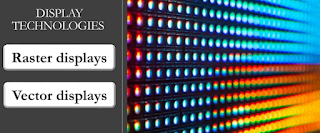Display Technologies in Computer Graphics: Definition and Types
Display technologies are the engineering methods used to create visual representations on electronic devices. In the context of computer graphics, they play a crucial role in translating digital creations into the visual experiences we interact with.
1. Vector Display:
This technology, prevalent in the early days of computing (pre-1970s), relies on a cathode ray tube (CRT) similar to televisions. Unlike modern displays, it doesn't use pixels. Instead, it directly controls the electron beam of the CRT to draw lines and shapes based on mathematical instructions.
Strengths:
Sharp lines and graphics: Ideal for technical drawings, CAD designs, and early video games with basic shapes.
Scalability: Vector graphics are resolution-independent, meaning they can be scaled to any size without losing quality.
Weaknesses:
Limited color palette: Early models were mostly monochrome, offering limited color capabilities.
Difficulty displaying complex images: Struggles to display detailed images like photographs or realistic textures.
Flickering: Refreshing the display could cause noticeable flickering, especially with complex images or text.
2. Raster Display:
This is the dominant technology today, present in all modern computers, TVs, and smartphones. Raster displays work by dividing the screen into a grid of tiny squares called pixels. Each pixel can be individually controlled to display a specific color or brightness, forming the image.
Strengths:
Rich colors and detailed images: Capable of displaying a vast spectrum of colors and intricate details, making them suitable for photographs, videos, and complex graphics.
Efficient for displaying images: More efficient at rendering and displaying complex images compared to vector displays.
Weaknesses:
Resolution limitations: Image quality is directly tied to the display resolution, meaning scaling can lead to pixelation (loss of detail).
Not ideal for vector graphics: While possible, displaying vector graphics on raster displays can result in jagged lines due to the inherent pixel-based nature.
Additionally:
Must-Display Definitions: These are specific characteristics (color gamut, resolution, etc.) that displays must meet to accurately render visual information consistently across devices.
Beyond these two main categories, several other display technologies exist for specific applications:
- Digital Light Processing (DLP): Uses tiny mirrors to project images, often used in projectors.
- Field Emission Displays (FED): Similar to OLEDs but with lower power consumption and potentially longer lifespans, primarily used in research and development.
- Electronic Paper (ePaper): Mimics the look and feel of traditional paper, offering high readability and low power consumption, often used in e-readers.


No comments:
Post a Comment